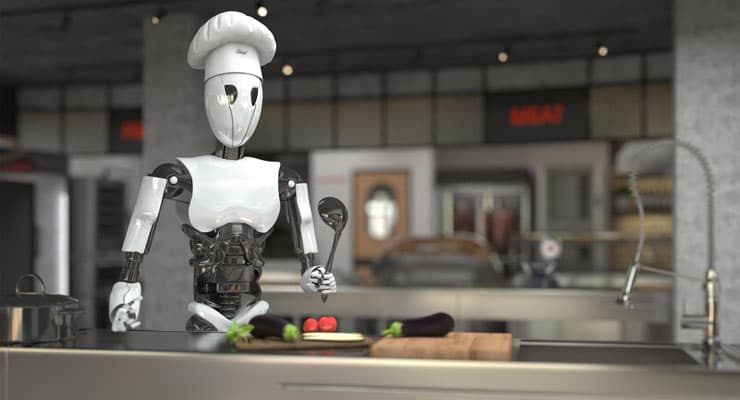
The art of automation
Simon Böckenholt, Head of Sales at BRIMATO Catering Automation Technology GmbH in Hilter, Germany, joins us to explain why the catering industry is set to be a leading area of automation technology in the future.
In which catering sectors is BRIMATO active?
Simon Böckenholt: The BRIMATO product portfolio can be found in commercial kitchens and large-scale canteens, such as hospitals, dining halls, staff canteens and in-flight caterers as well as large catering companies. We make a key contribution to automation and thus to the optimisation of processes. Our systems are capable of automatically executing recurring, repetitive and difficult tasks, which in turn reduces operating costs in the medium term.
Automation is currently an extremely hot topic. How do you use automation to achieve a reduction in operating costs?
Simon Böckenholt: In order to achieve an optimal level of automation, we start by analysing existing structures and processes in order to automate them at key points. Depending on the size of the plant and degree of automation, the payback period for the investment is only between 8 and 24 (36) months.
What machines does BRIMATO offer for process automation?
Simon Böckenholt: The BRIMATO automation systems range from cutlery sorting and packaging units to automated food distribution conveyor systems and automation solutions for before and after dishwashing lines.
Our machines are technically mature, cost-optimised and proven in practice. Their effectiveness in everyday use is confirmed in countless plants all over the world every single day.

Automatic cutlery sorting system CSS-8500-4-LR
What is the export share?
Simon Böckenholt: Some 50% of our products are exported; the main markets are Central, Western and Northern Europe.
Why is automation technology the future of the catering industry?
Simon Böckenholt: Today's catering industry is marked by acute staff shortages. There are simply not enough workers. Through automation, our systems can take over certain tasks and make work much easier for actual employees. Reducing workloads through automation means freeing up staff for more demanding and interesting tasks. This results in a better working atmosphere and higher staff retention. And since this also reduces the need to recruit and hire staff, managers also have more time to dedicate to their core tasks.
The coronavirus pandemic has brought hygiene into the spotlight, especially in commercial catering. Do machines also have a positive influence in this area?
Simon Böckenholt: Yes – hygiene conditions are definitely improved, too! Wherever people meet and eat together, there are contact points for the transmission of pathogens. Automation reduces the need to handle trays, plates and cutlery and thus also the number of contact points. This automatically minimises the risk of contamination.
One contact point that is often underestimated is the cutlery dispenser, for example. This open area where people help themselves to cutlery is an ideal point for the transmission of pathogens. When taking their cutlery, every diner touches several more sets, which are then used by others.
If cutlery is packaged under controlled hygienic conditions, contamination with harmful pathogens is minimised. This protects diners from infection.
Can the machines also be individually configured to meet customer requirements?
Simon Böckenholt: We cover a large number of applications with our standard BRIMATO product portfolio. However, we are regularly approached by customers who require an extremely individual solution. Precisely for such cases, we offer our BRIMATO special machine construction to provide solutions for such requirements and tailor products to the specific needs and conditions on site.

CPM-600 cutlery packaging machine
Which product is your top seller?
Simon Böckenholt: The B.PRO CPM-600 cutlery packaging machine. This machine is the embodiment of hygiene and cost efficiency. The CPM-600 packs cutlery sets together with a napkin in individually printable, closed paper bags. The bag is completely sealed. The contents cannot slip out and everything remains hygienically clean and dry until use.
The compact machine also achieves an extremely high performance. It can be operated by just one person and processes up to 600 pieces per hour. The cutlery is only handled once before being hygienically packed in a bag. The risk of contamination is thus almost completely eradicated. Another advantage of the machine is its plug & play function. The B.PRO CPM-600 cutlery packaging machine is simply placed wherever required and connected to the power supply. And then it is ready to go.
Can the CPM-600 cutlery packaging machine do anything else in addition to hygienically packing cutlery?
Simon Böckenholt: As well as packing cutlery sets, the CPM-600 can also pack a range of additional items, such as napkins, toothpicks, salt and pepper. The packaging can also be printed with an individual logo or message.

Simon Böckenholt is Head of Sales at BRIMATO Catering Automation Technology GmbH in Hilter
Thank you for the interesting and insightful conversation, Mr Böckenholt!
 Eye-catcher with added value
Eye-catcher with added valueA customised look for catering products brings real benefits for managers and guests. Whether colour accents, decors or logos, B.PRO offers a wide range of options for personalising food serving counters and other equipment.
 Company restaurant with a feel-good atmosphere
Company restaurant with a feel-good atmosphereThe modernisation of the Bühler company restaurant and snack bar at its site in Leobendorf, Austria is already yielding tangible results among employees. B.PRO contributed solutions for modern food serving.
 Expertise from one single source
Expertise from one single sourceB.PRO supplies system solutions that have it all: They increase the attractiveness of the culinary offer and facilitate work processes. This holistic approach is also evident in project management.
